CHAPTER XVII.
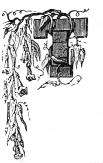
HE Van Cortlandt mansion, of which a sketch appears
in the last Chapter, is clustered with historic associations. It was the summer
home of the master, whose town residence was a stately one for the colonial
times. There, at early, as well as at later, periods, the wealthy and the
high-born of the land frequently assembled as guests. From its broad piazza
the famous Whitefield preached to a large audience upon the lawn. There, in
1774, Governor Tryon, and Edmund Fanning, his secretary, came on a mission
of bribery to General Van Cortlandt, who had espoused the cause of the colonists.
They offered him lands and titles for his allegiance to the crown, but they
were refused. Under that roof the illustrious Washington was a frequent guest
when the army was in that vicinity; and the parlour was once honoured by the
presence of the immortal Franklin. There may be seen many mementoes of the
past: the horns of a stag killed on the manor, when deer ran wild there; the
buttons from the yager coat worn by one of the captors of André a box
made of the wood of the Endeavour, the ship in which Cook navigated
the globe, et cetera.
On the morning after my arrival, accompanied by Mrs. Van Cortlandt, I rode to the village of Croton, a mile distant, to visit one of twin sisters, who were ninety years old in August, 1860.* On our way we turned into the cemetery of the Van Cortlandt family, upon a beautiful point of land, commanding an extensive view of the Hudson southward. A little west of the cemetery, at the neck of land which connects Croton Point with the main, stood the old fort or castle of Kitch-a-wan, said to have been one of the most ancient Indian fortresses south of the Highlands. It was built by the Sachem Croton, when he assembled his parties for hunting or war. In a beautiful nook, a little cast of the site of the fort, on the borders of Haunted Hollow, is the Kitch-a-wan burying-ground. Around this locality hovers the memory of many a weird story of the early times, when the superstitious people believed that they often saw, in the groves and glens there, the forms of the departed red men. They called them the Walking Sachems of Teller's Point.
* These sisters were living at the beginning of 1866.
We visited one of the twin sisters at Croton, Mrs. Miriam Williams. Her memory of long-past events seemed very faithful, but the mind of her sister had almost perished with age. They had both lived in that vicinity since their birth, having married and settled there in early life. Mrs. Williams had a perfect recollection of Washington, when he was quartered with the army near Verplanck's Point. On one occasion, she said, he dismounted in front of her father's house, and asked for some food. As he entered, the twins were standing near the door. Placing his hands upon their heads, he said, "You are as alike as two eggs. May you have long life." He entered with her father, and the children peeped curiously in at the door. A morsel of food and a cup of cold water was placed upon the table, when Washington stepped forward, laid his hand upon the board, closed his eyes, and reverently asked a blessing, their father having, meanwhile, raised his hat from his head. "And here," said Mrs. Williams, pointing to a small oval table near her, "is the very table at which that good man asked a blessing."
From the little village of Croton, or Collaberg Landing, I rode
to the dwelling of a friend (James 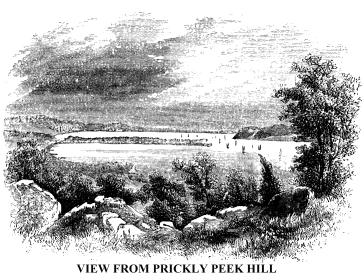 Cockroft,
Esq.), about two miles northward, passing on the way the old house of Tellar
(now Moodie), where the incident just related occurred. Accompanied by Mr.
Cockroft and his neighbour, J.W. Frost, Esq., I climbed to the summit of Prickly
Pear Hill (so called from the fact that a species of cactus, called Prickly
Pear, grows there abundantly), almost five hundred feet above the river, from
which may be obtained the most extensive and interesting views in all that
region. From no point on the Hudson can be seen, at a glance, such a cluster
of historic localities, as from this eminence. Here Washington was encamped
in 1782, and made this pinnacle his chief observatory. At one sweep of the
vision may be seen the lofty ranges of the Highlands, and the Fish Kill Mountains,
with all the intervening country adjacent to Peek's Kill, Verplanck's and
Stony Points, the theatres of important military events during the war for
independence; Haverstraw, where Arnold and André had their conference;
Teller's Point, off which the Vulture lay, and from which she received a cannonading
that drove her down the river; King's Ferry, where André crossed the
Hudson; the place of Pine's Bridge on the Croton, where he was suspected;
Tarrytown, where he was captured, and the long wharf of Piermont, near Tappan,
where he was executed. All of these, with the villages on the eastern shore
of the Hudson, from Cruger's to York Island, may be seen from this hill. Before
it lies Haverstraw Bay, the widest expanse of the Hudson, with all its historic
and legendary associations, which limited space forbids us to portray. Here
the fresh and salt water usually contend most equally for the mastery; and
here the porpoise,* a sea-water fish, is often seen in large numbers, sporting
in the summer sun. Here, in the spring, vast numbers of shad are caught while
on their way to spawning places in fresh-water coves; and here, at all seasons,
most delicious fish may be taken in great abundance. All things considered,
this is one of the most interesting points for a summer residence to be found
on the Hudson.
Cockroft,
Esq.), about two miles northward, passing on the way the old house of Tellar
(now Moodie), where the incident just related occurred. Accompanied by Mr.
Cockroft and his neighbour, J.W. Frost, Esq., I climbed to the summit of Prickly
Pear Hill (so called from the fact that a species of cactus, called Prickly
Pear, grows there abundantly), almost five hundred feet above the river, from
which may be obtained the most extensive and interesting views in all that
region. From no point on the Hudson can be seen, at a glance, such a cluster
of historic localities, as from this eminence. Here Washington was encamped
in 1782, and made this pinnacle his chief observatory. At one sweep of the
vision may be seen the lofty ranges of the Highlands, and the Fish Kill Mountains,
with all the intervening country adjacent to Peek's Kill, Verplanck's and
Stony Points, the theatres of important military events during the war for
independence; Haverstraw, where Arnold and André had their conference;
Teller's Point, off which the Vulture lay, and from which she received a cannonading
that drove her down the river; King's Ferry, where André crossed the
Hudson; the place of Pine's Bridge on the Croton, where he was suspected;
Tarrytown, where he was captured, and the long wharf of Piermont, near Tappan,
where he was executed. All of these, with the villages on the eastern shore
of the Hudson, from Cruger's to York Island, may be seen from this hill. Before
it lies Haverstraw Bay, the widest expanse of the Hudson, with all its historic
and legendary associations, which limited space forbids us to portray. Here
the fresh and salt water usually contend most equally for the mastery; and
here the porpoise,* a sea-water fish, is often seen in large numbers, sporting
in the summer sun. Here, in the spring, vast numbers of shad are caught while
on their way to spawning places in fresh-water coves; and here, at all seasons,
most delicious fish may be taken in great abundance. All things considered,
this is one of the most interesting points for a summer residence to be found
on the Hudson.
*Porpoise communis; genus Phocaena, supposed to be the Tursio of Pliny. It is from four to eight feet in length, nearly of a black colour above, and whitish beneath. They are found in all our northern seas and bays. The swim in shoals, and pursue other fishes up bays and rivers, with the avidity of hounds after game. In fine weather they leap, roll, and tumble, to great glee, especially in late spring time. They yield a very fine oil.
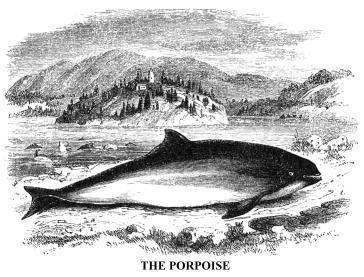 The
highways, on land and water, from the Croton to the Spuyten Duyvil Creek,
at the head of York Island, pass through exceedingly beautiful and picturesque
scenery, made classical to the American mind because of most interesting historical
associations. On the west side of the Hudson, seen by the traveler on road,
railway, or river, is a bold mountain shore, having a few cultivated slopes
and pleasant villages as far down as the lower extremity of Tappan Bay. From
that point there are presented, for about twenty miles southward, perpendicular
walls of rock, with bases in buttress form, called the Palisades, fronting
immediately on, and rising several hundred feet above, the river. On the cast
the voyager sees a beautiful, high, undulating country, well cultivated, and
sprinkled with villages and hamlets.
The
highways, on land and water, from the Croton to the Spuyten Duyvil Creek,
at the head of York Island, pass through exceedingly beautiful and picturesque
scenery, made classical to the American mind because of most interesting historical
associations. On the west side of the Hudson, seen by the traveler on road,
railway, or river, is a bold mountain shore, having a few cultivated slopes
and pleasant villages as far down as the lower extremity of Tappan Bay. From
that point there are presented, for about twenty miles southward, perpendicular
walls of rock, with bases in buttress form, called the Palisades, fronting
immediately on, and rising several hundred feet above, the river. On the cast
the voyager sees a beautiful, high, undulating country, well cultivated, and
sprinkled with villages and hamlets.
The drive from Sing Sing to King's Bridge at Spuyten Duyvil
Crock, along the old post-road, is 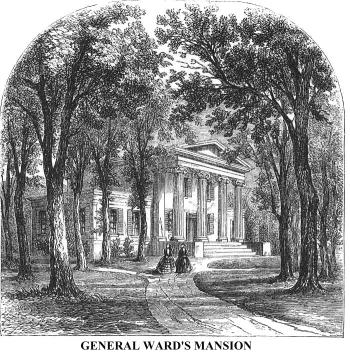 attractive
at all seasons of the year, but more especially in spring and early summer,
when the trees are in leaf, because of the ever-varying aspects of the landscape.
Fine mansions and villa residences are seen on every side, where, only a few
years ago, good taste was continually offended by uncouth farmhouses, built
for utility only, without a single thought of harmony or beauty. Now all is
changed, and the eye is as continually pleased.
attractive
at all seasons of the year, but more especially in spring and early summer,
when the trees are in leaf, because of the ever-varying aspects of the landscape.
Fine mansions and villa residences are seen on every side, where, only a few
years ago, good taste was continually offended by uncouth farmhouses, built
for utility only, without a single thought of harmony or beauty. Now all is
changed, and the eye is as continually pleased.
One of the finest of the older country seats in this region was the mansion of General Aaron Ward, overlooking the village of Sing Sing, and commanding a very extensive view of the Hudson and its distant shores. General Ward is one of the most distinguished men in Westchester County, and is descended from an early settler in that region. He was an officer in the American army during the war with Great Britain in 1812--15, and at its close conducted the first detachment of the British prisoners from the States to Canada. Law was his chosen profession, and in 1825 he became a law-maker, by election to the Lower House of the National Congress. He was an active and efficient worker, and the satisfaction of his constituency was certified by their retaining him as their representative, by re-election, twelve out of eighteen consecutive years. He assisted in framing the present constitution of the State of New York, in 1846, and since then has declined invitations to public service. During the years 1859 and 1860, he visited Egypt and the Holy Land. His narrative of his journey, published under the title of "Around the Pyramids," is considered one of the most truthful productions of its kind from the pen of an American. Sing Sing owes much to General Ward's enterprise and public spirit, and he is sincerely honoured and beloved in the community where he resides.
Pleasant residences--some embowered, others standing out in the bright sunlight near groves and woods--delight the eye more and more as we approach the large village of Tarrytown, twenty-seven miles from New York. Of these the most conspicuous between the little hamlet of Scarborough, below Sing Sing and Tarrytown, is that of Mr. Aspinwall, a wealthy New York merchant. Near it was the residence of General James Watson Webb, then the veteran editor and proprietor of the New York Courier and Inquirer, and well known, personally, and by reputation, in both hemispheres as a gentleman of rare abilities as a journalist. At the beginning of the Civil War, General Webb was appointed resident minister at the court of Pedro II., emperor of Brazil, in which position he continued during the entire struggle.
Approaching Tarrytown, we observe upon the left of the highway
an already populous cemetery, covering the crown and slopes of a gentle hill.
Near its base is an ancient church, and a little beyond it flows a clear stream
of water, which the Indians called Po-can-te-co, signifying a "run
between two hills." It makes its way in a swift current from the back
country, between a hundred hills, presenting a thousand scenes of singular
beauty in its course. The Dutch named it Slaeperigh Haven Kill, or
Sleepy Haven Creek, and the valley in the vicinity of the old church, through
which it 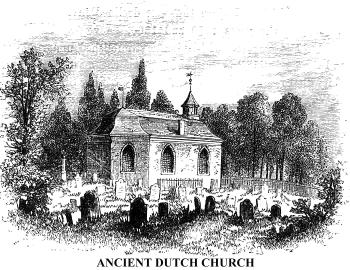 flowed,
Slaeperigh Hol, or Sleepy Hollow, the scene of Washington Irving's
famous legend of that name.
flowed,
Slaeperigh Hol, or Sleepy Hollow, the scene of Washington Irving's
famous legend of that name.
The little old church is a curiosity. It was built, says an
inscription upon a small marble tablet on its front, by "Frederic Philips
and Catherine Van Cortland, his wife, in 1699," and is the oldest church
edifice existing in the State of New York. It was built of brick and stone,
the former imported from Holland for the purpose. Over its little spire still
turns the flag-shaped vane of iron, in which is cut the monogram of its founder
(VF in combination, his name being spelt in Dutch, Vedryck Flypsen); and in
the little tower hangs the ancient bell, bearing the inscription in Latin,
"If God be for us, who can be against us? 1685." The pulpit and
communion table were also imported from Holland. The former was long since
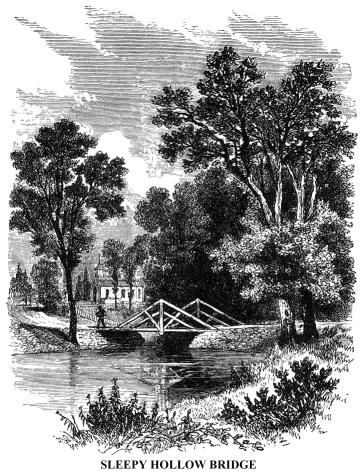 destroyed
by the iconoclastic hand of "improvement."
destroyed
by the iconoclastic hand of "improvement."
At this quiet old church is the opening of Sleepy Hollow, upon the shores of the Hudson, and near it is a rustic bridge that crosses the Po-can-te-co, a little below the one made famous in Irving's legend by an amusing incident.* In this vicinity, according to the legend, Ichabod Crane, a Connecticut schoolmaster, instructed "tough, wrong-headed, broad-skirted, Dutch urchins" in the rudiments of learning. He was also the singing-master of the neighbourhood. Not far off lived old Baltus Van Tassel, a well-to-do farmer, whose house was called Wolfert's Roost. He had a blooming and only daughter named Katrina, and Ichabod was her tutor in psalmody, training her voice to mingle sweetly with those of the choir which he led at Sabbath-day worship in the Sleepy Hollow Church. Ichabod "had a soft and foolish heart toward the sex." He fell in love with Katrina. He found a rival in his suit in stalwart, bony Brom Van Brunt, commonly known as Brom Bones. Jealousies arose, and the Dutchman resolved to drive the Yankee school-master from the country.
* "Over a deep, black part of the stream, not far from the church," says Mr. Irving, is his "Legend of Sleepy Hollow," "was formerly thrown a wooden bridge; the road that led to it, and the bridge itself, were thickly shaded by overhanging trees, which cast a gloom about it even in the daytime, but occasioned a fearful darkness at night."
Copyright © 1998, -- 2004. Berry Enterprises. All rights reserved. All items on the site are copyrighted. While we welcome you to use the information provided on this web site by copying it, or downloading it; this information is copyrighted and not to be reproduced for distribution, sale, or profit.